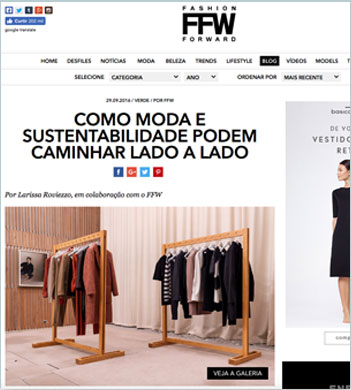


Sustainability, eco, ethics, sustainable fashion, green … these terms and expressions are full of meanings and little by little, take space and become more and more visible in our day to day. But of course, like every trend (or most), there is no innovation if there is no reason. Fashion is one of the largest industries in the world, both in the sense of economic development and job creation, as well as the consumption of natural resources – raw materials, energy, water and chemicals – needed to make this segment spin. And despite all the grandeur and glamor, you have to think about the impact that the industry has on our planet and the people directly related to it, information that is usually far from the windows and magazines.
Like everything in life, the “bill always comes”, and it’s no use running, we’ll have to pay sometime. That is precisely why all these new terms are so much in evidence today, because there is a need to innovate this industry that is so much a part of our life, even indirectly. An example that can demonstrate the impact of industry in general is the study done in 2015 in the USA by Levi Strauss & Co, the famous Levi’s®. According to the data, a jeans uses 3,781 liters of water throughout its production and use cycle. This number ranges from growing cotton to manufacturing and caring for consumers at home, with only the development of cotton fiber using 68% of that total. In addition, we must mention the impact of the synthetic chemicals used in the dyeing process, a serious problem identified by Greenpeace since 2010.
From this need for innovation, new business models emerge that inspire and show that there are possibilities, just get out of the conventional. Innovation to reduce environmental impacts, water reuse, renewable energy, better conditions for workers, recycling of raw materials and many other things.

As an example of business driving this change using circular economy as a concept, is the Danish brand VIGGA. With the principles of reduce, reuse and recycle, she believes that it is no use to develop clothes in a sustainable way if this clothing is used a few times and thrown away. That means a lot of energy, raw material and effort for little use. Thinking about it, the brand, focused on baby clothes, offers a signature system in which the consumer pays a monthly value and receives a selection of clothes according to the size of the child.
And as long as these clothes no longer fit, parents send them back, receive new ones at a larger size, and after a special cleaning, VIGGA has the opportunity to send those clothes to other families, repair when needed, or recycle The material when it is no longer suitable for use. A cyclical system that benefits all involved: consumers, business, industry and the environment. And it has one more differential: the pieces are developed with organic cotton and wool free of chemicals harmful to the health.

Also aiming for a circular economy, the Swedish brand Filippa K offers the collection parts rental service as an opportunity for the consumer to stay current, without the need to consume and accumulate clothes in the wardrobe (see more). It is possible to rent the pieces for four days paying 20% of the value. On the site, they also have a section with care tips to make their clothes last longer.
They also collect pieces that customers no longer want, offer a 15% voucher for each returned item, restate it when needed and make it available again in the second hand shop. It is important to note that Filippa K, despite having a second hand session since 2008, makes a different context than we are conditioned to think. They are not vintage pieces like in brechó, or pieces abused and often with strong smell. The brand takes this idea to another level, investing in Visual Merchandising and ways to reuse this product. Of course, when it is not possible to commercially afford the piece, they are sent to humanitarian organizations. That is, in addition to other actions thinking of a more sustainable fashion, the brand is increasingly investing in solutions for the disposal of the product, in order to minimize the impacts on our environment.
Another interesting work to mention is that of companies that transform wasted materials into raw materials, developing new products and giving new life to waste. This process, called Upcycling, is the business model used by the Brazilian brand Insecta Shoes, which uses fabrics and disused clothes to make their shoes.

Another important national example that embraces this cause is À La Garçonne, by Fabio Souza and Alexandre Herchcovitch. With a low-scale production, the brand develops unique pieces from the garimpo of ready-made garments, forgotten fabrics and recycled materials. A work in which sustainability comes through the designer’s creativity, design and technical experience.
But of course not everything is flowers. Just as today’s industry took time and learned from its own mistakes to be this great empire, which unfortunately causes great impacts on our planet, these business models are part of the changes and solutions to a new consciousness in the industry.
And the creators of these new projects continue to improve the operation and process from customer feedback and problems that come in the way. What is important is that they exist and that consumers and entrepreneurs understand the need for change by identifying and supporting those ideas.
Fashion is irreversibly moving towards a new reality, where those who think, make and make available the products, have a great responsibility. Rethinking and reviewing the current process is necessary, and opens space for new ideas to make viable, make and consume fashion.
* Larissa Roviezo is Brazilian and lives in Berlin, where she makes a Master and Sustainable Fashion at Esmod Berlin, one of the pioneering institutions in this approach @lariroviezzo @forbetterfashion
from: http://ffw.uol.com.br/blog/verde/como-moda-e-sustentabilidade-podem-caminhar-lado-a-lado/